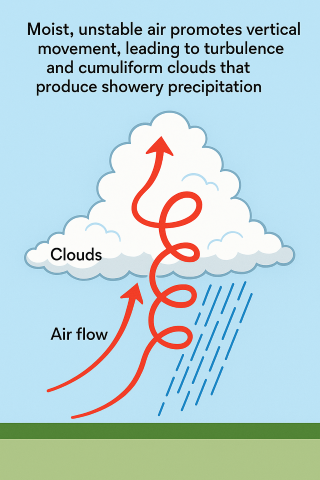FAAWhat are characteristics of a moist, unstable air mass?
- ✅A:Turbulence and showery precipitation.
- ❌B:Poor visibility and smooth air.
- ❌C:Haze and smoke.
Answer Figure

Click to enlarge answer figure
Explanations
- A: Correct. A moist, unstable air mass is characterized by turbulence and showery precipitation. This is due to the vertical movement of air that promotes the formation of cumuliform clouds. For a commercial drone operator, understanding these weather conditions is crucial for safety and operational planning. Flying in such conditions could lead to loss of control, potential collision, and damage to the drone. Additionally, it could result in regulatory violations if the drone is operated in unsafe conditions.
- B: Incorrect. Poor visibility and smooth air are characteristics of a stable air mass, not an unstable one. Misunderstanding these conditions could lead to poor decision-making, potentially compromising the safety of the drone operation and leading to regulatory violations.
- C: Incorrect. Haze and smoke are pollutants and not defining characteristics of air mass instability. Misinterpreting these conditions could lead to poor operational planning, potentially compromising safety and regulatory compliance.
🧭 Instructor Note
Why This Matters for Your Business
Understanding weather conditions, particularly the characteristics of air masses, is crucial for the safe and efficient operation of your commercial drone business. Misjudging these conditions can lead to operational disruptions, potential damage to your equipment, and regulatory violations, all of which could negatively impact your profitability and reputation.
Safety & Liability Considerations
Operating a drone in a moist, unstable air mass can lead to turbulence and showery precipitation. These conditions can cause loss of control, potential collision, and damage to the drone. Moreover, flying in such conditions could result in regulatory violations, leading to fines and potential legal issues.
Consider This Scenario
Imagine a real estate company that uses drones for aerial photography. The drone operator misjudges the weather conditions, mistaking a moist, unstable air mass for a stable one. The drone is launched, but the turbulence and showery precipitation cause loss of control. The drone crashes, causing damage to the equipment and delaying the project. This scenario highlights the importance of understanding weather conditions for safe and efficient drone operation.
What the FAA is Testing
The FAA wants to ensure that drone operators understand the characteristics of different air masses and can make informed decisions about when it is safe to fly. Misjudging these conditions can lead to unsafe operations and potential regulatory violations.
Business Success Strategy
Invest in weather forecasting tools and training to ensure that your drone operators can accurately assess weather conditions. This will help to ensure the safety of your operations, compliance with regulations, and the satisfaction of your clients.
Memory Aid
Remember the phrase "Unstable Upheaval" to associate unstable air masses with upward movement, turbulence, and showery precipitation.
Enhanced References
FAA's Pilot's Handbook of Aeronautical Knowledge (Chapter 11: Weather Theory), Case Study: Drone Operation in Unstable Weather Conditions.
Related Concepts
- Understanding weather conditions for safe drone operation
- Impact of air mass stability on drone flight
- Regulatory implications of flying in unstable weather conditions
ACS Code: UA.III.B.K1d
Difficulty: basic
